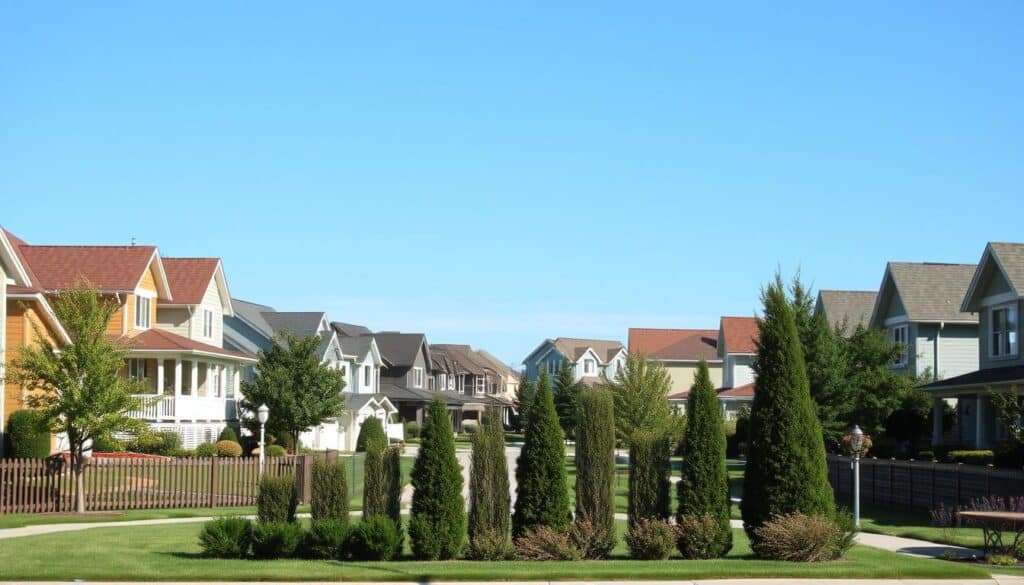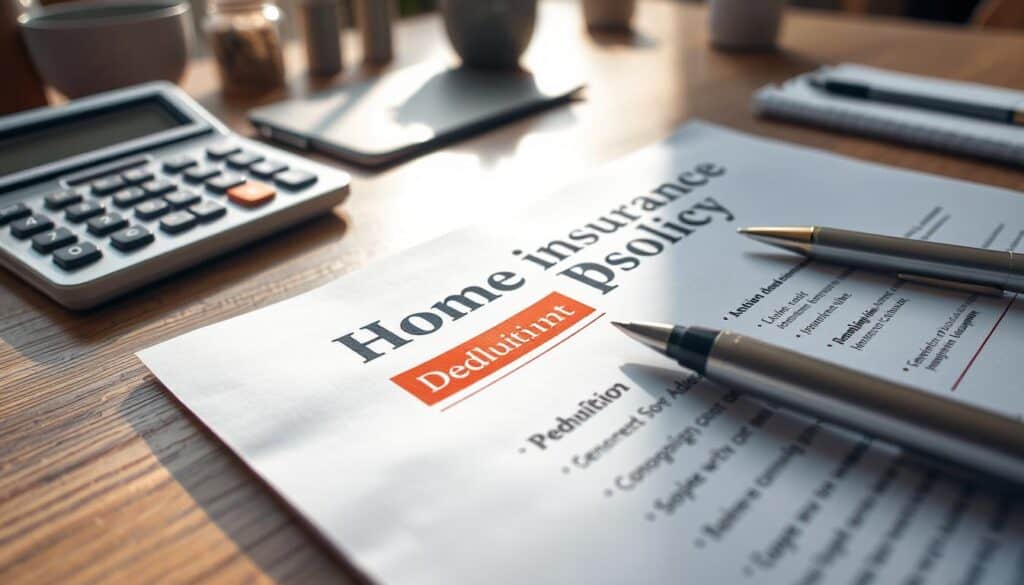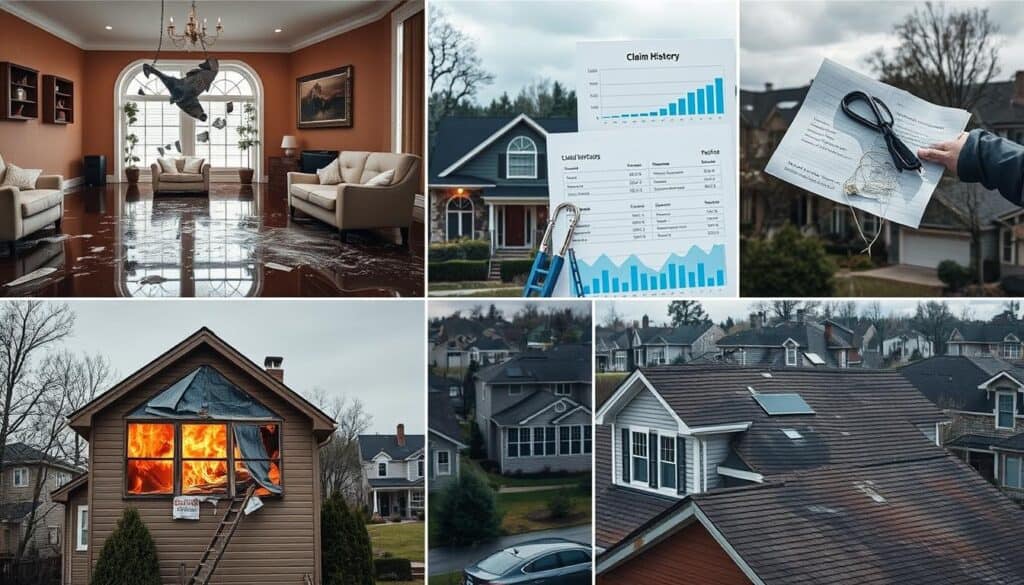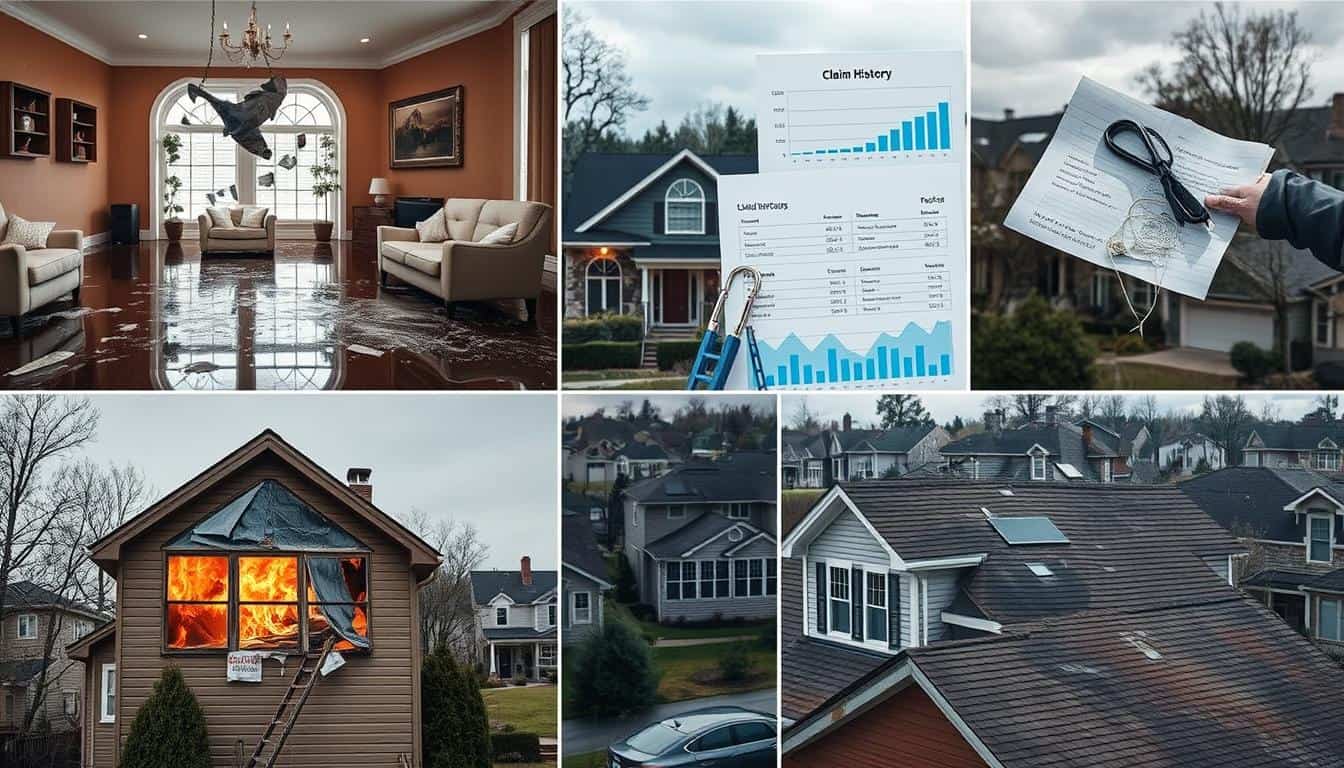As a homeowner, knowing what affects your home insurance rates is key to saving money. For a deeper dive into how home insurance works and tips on finding the best coverage, check out our Comprehensive Guide to Home Insurance. Insurers look at many things to figure out how much to charge you. This includes where your home is, how old it is, and if you’ve filed claims before.
With home insurance costs going up, it’s vital to understand these factors. By knowing what affects your rates, you can make choices to lower them. This helps protect your money. So, let’s explore the 7 main things that can change how much you pay for home insurance.

Key Takeaways
- Your home’s location, including weather risks, crime rates, and proximity to emergency services, can significantly affect your insurance premiums.
- Newer homes with modern safety features may qualify for lower premiums compared to older properties with outdated systems.
- Higher coverage limits typically result in higher premiums, but can provide greater financial protection in unexpected events.
- Opting for higher deductibles can lower your premiums, as you pay more out-of-pocket before the insurer contributes.
- Your claims history, especially for significant losses, can indicate a higher likelihood of future claims and lead to increased premiums.
Location: A Significant Determinant
Your location greatly affects your home insurance rates. Insurance companies look at geographical risks, proximity to emergency services, and crime rates in your area. This helps them set your premiums.
Homes in areas prone to natural disasters, like hurricanes or tornadoes, cost more. Also, homes in high-crime areas have higher insurance costs. But, homes near fire stations or hydrants might get discounts because they’re seen as safer.
The average cost of home insurance varies a lot by state and region. For example, Oklahoma’s average annual cost is $4,675, while Alaska’s is $1,189. This difference is due to different disaster risks. Also, a home’s age, condition, and safety features can change insurance costs.
To get the best rates, research your local area’s risks and safety features. Knowing how your location impacts your insurance can help you save a lot.
“Homeowners insurance in New Jersey not only provides coverage but also offers peace of mind and protection for personal property and assets.”
Dwelling Coverage: Determining the Replacement Cost
Home insurance’s dwelling coverage is key to your premiums. It protects your home’s structure. Insurance companies use tools to guess the rebuild cost after a loss. The rebuild cost often includes labor and materials, which might be more than your home’s market value.
Knowing what affects your home’s rebuild cost is important. This ensures you have enough coverage.
Age and Condition of Your Home
Your home’s age and condition greatly affect its rebuild cost. Older homes might need special materials and labor, raising costs. Unique features or updates also play a role in the rebuild cost.
Square Footage and Architectural Features
The size and design of your home matter for rebuild cost estimates. Bigger homes with complex designs cost more to rebuild. Insurers use tools to set coverage limits based on these factors.
Local Construction Costs
Your home’s location and local construction costs are also key. Building costs vary widely, from $60.35 to $226.39 per square foot. Luxury homes can cost up to $500 per square foot. Natural disasters can also raise labor and material costs, possibly exceeding coverage limits.
Working with your insurance agent is crucial to get the right coverage for your home’s rebuild cost. Some insurers offer extra coverage for unexpected rebuild costs.
“Accurately estimating the replacement cost of your home is crucial to ensuring you have the right coverage to protect your most valuable asset.”
Deductibles and home insurance rates
Your home insurance deductible is key to your rates. It’s the amount you pay before your coverage starts. Higher deductibles mean lower monthly costs. It’s vital to pick a deductible you can afford quickly if you need to make a claim.
Higher deductibles mean lower premiums. The average deductible is $1,000. Deductibles range from $100 to $5,000. Some deductibles are a percentage of your home’s value.
Insurance companies offer tools to adjust deductibles and see rate changes.
| Deductible Amount | Average Annual Home Insurance Cost | Savings Compared to $500 Deductible |
|---|---|---|
| $250 | $1,769 | – |
| $500 | $1,710 | – |
| $1,000 | $1,595 | $115 (7% savings) |
| $1,500 | $1,522 | $188 (11% savings) |
| $2,000 | $1,441 | $269 (16% savings) |
Raising your deductible can save you a lot. For example, going from $500 to $1,000 saves $115 a year. Going to $2,000 can save up to $269 annually. But, think about if you can afford it if you need to claim.
“Choosing the right home insurance deductible is a delicate balance between managing your monthly costs and ensuring you can afford to cover a potential claim. It’s important to work with your insurance provider to find the sweet spot that fits your budget and risk tolerance.”

Some policies have special deductibles for things like hurricanes or floods. Earthquake deductibles can be a percentage of your home’s value. Flood deductibles are usually between $1,000 and $10,000. Make sure you understand all deductibles in your policy.
In conclusion, your deductible greatly affects your premiums. A higher deductible can save you money. But, make sure you can afford it if you need to claim. Talk to your insurance provider to find the best balance.
Claims History: A Reflection of Risk
Your home insurance claims history can really affect your future premiums. If you’ve had many or big claims, insurance companies see you as a higher risk. This means you’ll likely pay more for your insurance.
How often you’ve filed claims matters a lot. If you’ve filed many, it means you might file more in the future. Also, the cost and severity of past claims can lower your insurance score. This is especially true for claims that caused a lot of damage or hurt someone.
Frequency and Severity of Past Claims
Even denied or old claims can still show up on your CLUE report. This can affect your insurance rates. A CLUE report shows claims from the last seven years. It can change how much you pay for insurance and if you get approved.
Insurance companies look at these reports closely. They check the types of losses, when they happened, how much they cost, and if they were settled.
Impact on Future Premiums
Having a history of claims can lead to higher premiums. Studies show that past claims are linked to future risks. Your credit score, how much you owe, and your payment history also play a part in your insurance rates.
It’s smart to avoid making small claims that don’t save you money. This keeps your premiums down by keeping your claims history clean.

“Mistakes in CLUE reports can occur, including errors in attributing accidents or claims without payouts, which should be disputed for correction.”
To get a CLUE report, you can reach out to LexisNexis online, by phone, or by mail. You get one free report a year thanks to the Fair and Accurate Credit Transactions Act (FACTA). If there are errors, you can work with insurance agents and LexisNexis to fix them.
Conclusion
Knowing what affects home insurance rates is key. This includes location, coverage, deductibles, claims history, and credit. By managing these, you can get good coverage at a lower cost. Rising costs and natural disasters can raise premiums. But, good credit, higher deductibles, and policy reviews can help keep costs down.
Being an informed consumer is crucial for affordable home insurance. Understanding rate factors and optimizing your policy protects your home and finances. This ensures your safety and security for years to come.
The home insurance world is always changing. By staying informed and proactive, you can adapt to these changes. This way, you can be confident in your coverage, no matter what the future brings.
FAQ
What is the average cost of home insurance?
The average cost of home insurance in the U.S. is $2,151 per year. Your exact rate depends on personal and property factors. These factors affect the risk for insurance companies.
What factors affect my home insurance rates?
Several factors can change your home insurance rates. These include your home’s location, coverage, deductible, claims history, and credit score. Your marital status and home’s age also matter.
How does my home’s location impact insurance rates?
Your home’s location is crucial. Insurance companies look at natural disaster risks, emergency service access, and crime rates. Homes in risky areas or high-crime zones have higher premiums. Homes near fire stations or hydrants might get discounts.
What is dwelling coverage, and how does it affect my rates?
Dwelling coverage protects your home’s structure. Insurance companies estimate rebuilding costs based on your home’s age, condition, and features. Local construction costs also matter. Upgrading or improving your home can lower premiums.
How does my deductible impact my home insurance rates?
Your deductible affects your rates. A higher deductible means lower premiums. But, make sure you can afford the deductible if you need to file a claim.
How does my claims history affect my home insurance rates?
Your claims history is key. Multiple or large claims raise your risk. Even denied or past claims can affect your rates. Your CLUE report shows this history.

